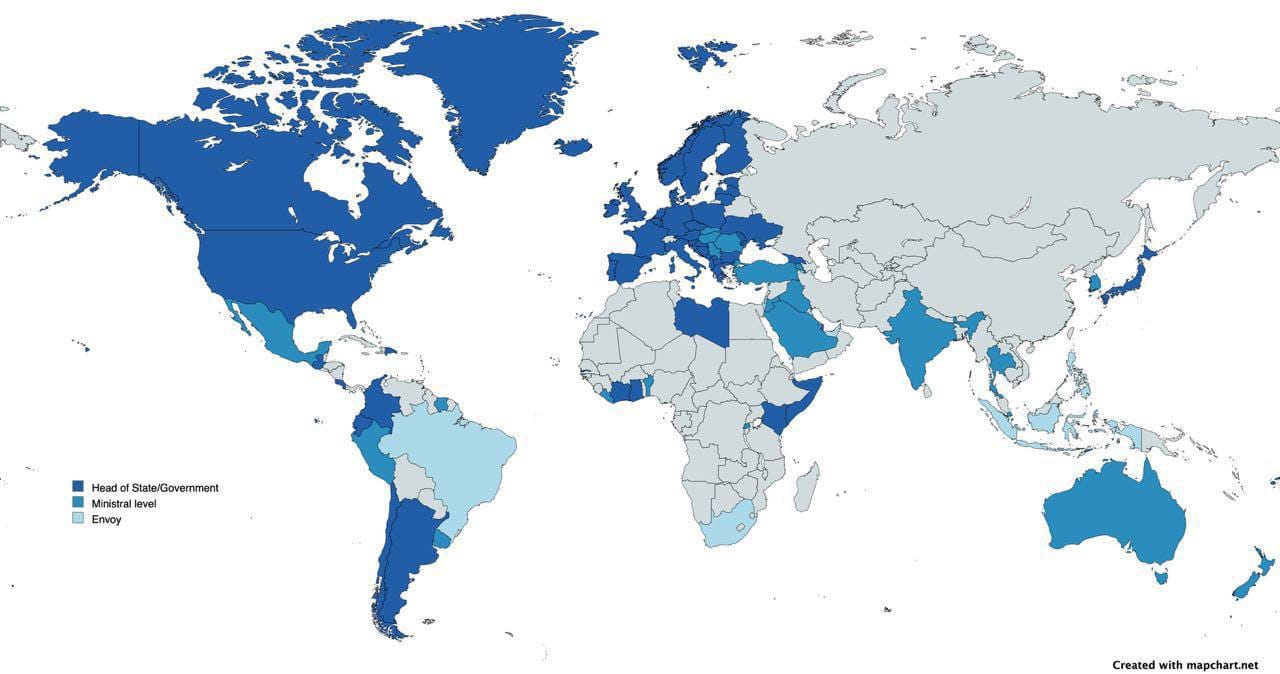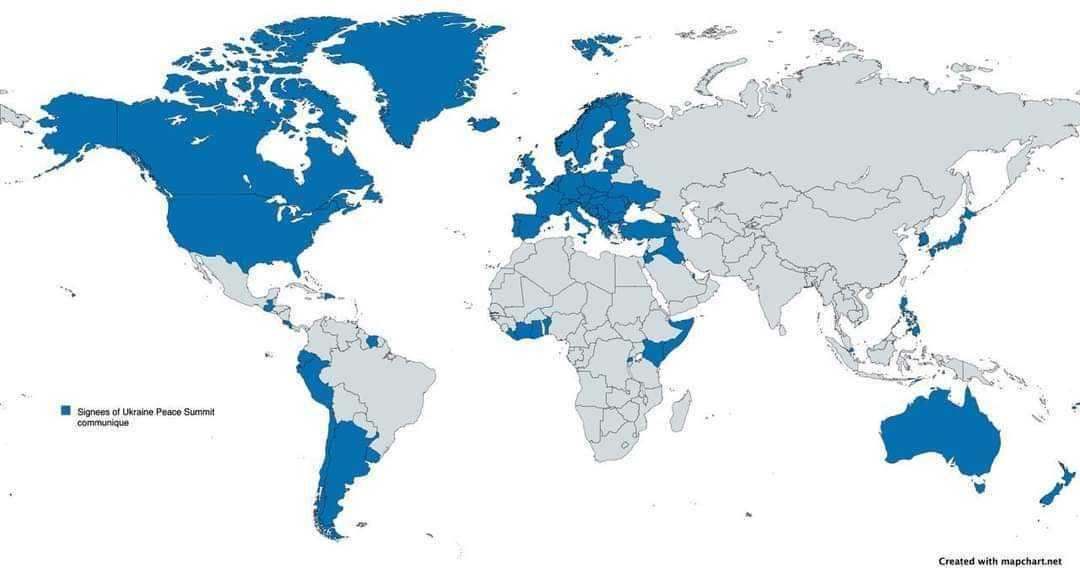The Global Peace Summit was a success both from the viewpoint of attendance of international states and their meaningful and substantial activity.
It was the first event within Ukraine’s peace formula process at such a high political level and size. The gathering of around 100 organizations and states was quite emblematic.

Ukraine succeeded in forming a wide coalition of those who respect the UN Charter and the principles of inviolability of borders and territorial integrity. This achievement must be celebrated.
Second, Ukraine has a communiqué signed by 80 countries.
There were many rumors and fears that it might not be so straightforwardly devoted to the Ukrainian issue. But in the end, Russia was named as the aggressor, and the document mentions that Russia wages a war of aggression against Ukraine. It demands Russia comply with international norms in three points of Ukraine’s 10-point peace plan:
- nuclear safety
- food safety
- the humanitarian dimension when it comes to an “all for all” prisoner swap.
This was despite the summit limiting its agenda to only three points of Zelenskyy’s 10-point peace formula, which were considered to be less divisive, specifically to appeal to the Global South.

Russia and China tried hard to dissuade partners from the Global South from attending, and they partially succeeded with regions of Asia and Africa. We see that Russia and China's leverage is still tremendous in these areas.
This means it will be an uphill struggle for Ukraine to persuade these regions. It will need to make it clear that Ukraine stands for abiding by the UN charter and international order. Ukraine needs to propose something of a global scale, not only connected to the Russian war against Ukraine.
Nevertheless, out of 92 states confirmed for participation, 80 signed. This is a good sign: quite a large number of countries are interested in restoring international order. Unfortunately, there are no BRICS states among the signatories. This drops a hint about the future tactics Russia may try to use to torpedo future activity.
Why 12 countries did not sign the communique
Some tried to keep their distance because they wanted to portray themselves as mediators, brokers, or intermediaries in negotiations. Their rationale is that they needed to keep this distance from Ukraine's position to be able to reach out to Russia.
Others, however, still fear relations with Russia souring because of economic and political dependencies. So, they tried to secure themselves from further Russian negative reactions by appearing at the summit but attempting to be more neutral.
Ukraine has a coalition on the highest level, the level of heads of states and governments, as well as on the ministerial level, and not simply on the technical level with national security advisors.
Another reason the summit was a success was that the communique and press conferences of state leaders contained notions in line with the philosophy of Ukraine’s 10-point peace formula, which means that these three limited points on the agenda of the peace summit - nuclear, food security and humanitarian dimension - have stronger wording and requests to Russia than simply their limited agenda.
Russia will ignore this, no doubt, but nevertheless, it proves that the world is fed up with Russian behavior and the trampling of international law.
What happens after the Global Peace Summit
Working groups on specific points of Ukraine’s 10-point peace plan have been created, and will be held in various countries. Some will focus on the three limited issues discussed at the summit, but others took on the seven points that are not on the agenda of this peace summit:
4. Ukraine’s energy security;
5. Restoring the Russia-Ukraine border to its pre-2014 state;
6. Russia’s full withdrawal from Ukraine and cessation of hostilities;
7. Prosecution of Russian war crimes;
8. Assessment of environmental damage, recovery, and reconstruction;
9. Guarantees against future Russian aggression;
10. A multilateral peace conference with a legally binding international treaty.
This is a good sign. Ukraine is still on the same track that we envisaged from the very beginning: that peace in Ukraine is only possible with the full withdrawal of Russian troops and cessation of Russian aggression. And this is the third reason for the summit's success.
After this first global summit, we can expect conferences and thematic working groups elaborating on instruments and enforcement for these norms in different areas. When the peace plan will be drafted and endorsed by the majority of participating states, this blueprint could be handed out to Russia to consider as a possibility for potential negotiations.
This process is even more important than the wide participation in the summit and the communique – because two pages of text from 80 countries is a very watered-down common denominator.

During the Plenary at the Summit on Peace in Ukraine at the Burgenstock 16 June 2024. FDFA/POOL/Pascal Lauener
The Peace Plan and the Peace Formula: two different things
Overall, we must understand that the peace plan is something different from Zelenskyy’s 10-point peace formula:
- the peace formula is an initiative from Ukraine;
- the peace plan is something designed by those participants taking part in working groups.
The peace plan would envisage ideas already proposed by Ukraine, for example, to withdraw Russian forces. Ukraine has also proposed a special mechanism to create a special international monitoring group to witness that everything goes as planned. I think some mechanisms might be developed during the work of this working group, but they likely won’t happen fast because even those points of global relevance that we mentioned - food security and nuclear security - still need to be elaborated in depth with mechanisms.
The steps touching upon Ukraine’s integrity and sovereignty will likely be in further stages.
There will be no intermediary summits, although we can juggle with the names of these international conferences - they might be sub-summits or mini-summits.
But such a high political level, with the participation of heads of states and governments, will be reserved only for the second summit and invitation of Russia.
We’re trying to elaborate different mechanisms for such an invitation. One could follow the formula of the grain initiative, where Russia and Ukraine signed two separate, identical documents. This way, we are not talking to Russia directly but have intermediaries who just hand over our plan to Russia and then give us direction.
Russia will only participate in the second summit if it agrees to the conditions elaborated in the peace plan. If Russia does not show such willingness, the second summit may be held without it, but it would be a summit of those willing to uphold the international order and international norm system.
Such a summit envisions Russia's military defeat, which is why the peace summit is not a unique or sole event. It is combined with the G7 meeting, with a strong emphasis on the Ukrainian situation. In two weeks, a significant meeting of the European Council will be held, which will decide on the opening of negotiations with Ukraine and Moldova, and in one month, the NATO summit in Washington, DC.
Ukraine has also signed an agreement with the United States and with Japan, which complements those secret agreements signed with other partners within a framework of 10 years.
That means that it's not only about looking for peace but also about buttressing up our position on the battlefield and in Ukraine’s political situation. Russia is trying to question the legitimacy of the Ukrainian president, as no elections were held over martial law, and our partners in the West are trying to give a clear message that politically, Ukrainian authorities are viable, and we have possibilities to support them on the battlefield and elsewhere.
Editor's note. The opinions expressed in our Opinion section belong to their authors. Euromaidan Press' editorial team may or may not share them.
Submit an opinion to Euromaidan Press
Related:
- Swiss peace summit abruptly revises communiqué to acknowledge Russian aggression
- What does Ukraine hope to achieve with the Global Peace Summit?
- Switzerland peace summit could be self-defeating for Ukraine, leaked draft shows

